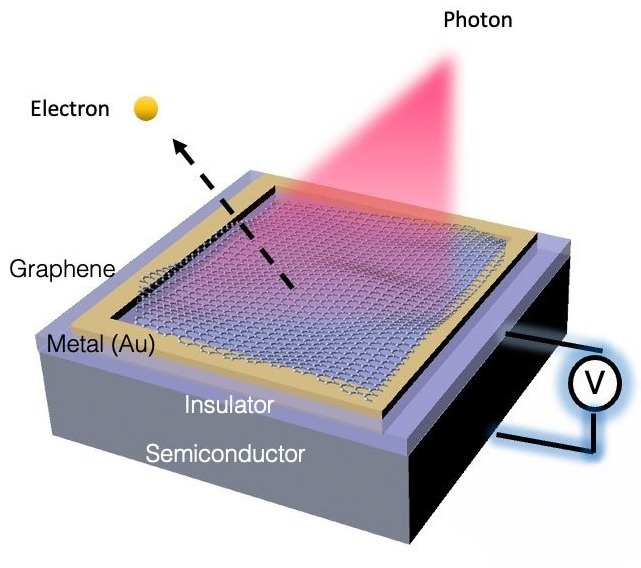The energy needed to expel an electron from a material is a fundamental characteristic that governs electron flow and is a crucial consideration in device design. Traditionally, altering this property required finding a different material suited to the specific application.

An insulator and graphene coating on a semiconductor changes the energy required for electrons to escape the material. This energy can typically be provided by a photon illuminating the structure. Image Credit: University of Southern California
However, researchers have recently demonstrated that, for particular semiconductors, this property can be electronically adjusted by applying a bilayer coating composed of an insulator and graphene on top of the semiconductor. By applying a voltage between the semiconductor and graphene, the energy required to eject electrons from the material is reduced.
The Impact
In numerous electrochemical devices, electrons depart from the semiconductor and subsequently trigger a reaction. The introduction of this novel bilayer coating holds promise for enhancing these devices by lowering the energy necessary to release electrons. Consequently, it reduces the input energy required for a reaction to occur, potentially increasing overall efficiency.
Moreover, electron accelerators, responsible for speeding up electron beams to generate electromagnetic radiation, stand to benefit from this coating. The quality of the electron beam at the point of emission can significantly impact the properties of the generated radiation, determining the potential applications of the accelerator. This innovative approach broadens the range of sources that can be utilized in these accelerator systems.
Summary
In this study, researchers from the University of Southern California achieved the ability to adjust the energy required to expel an electron by establishing layers with opposite charges on both the graphene and the semiconductor.
The coating comprises a slim insulating layer positioned between the semiconductor and graphene, with each layer serving a distinct role. The graphene layer functions as an electrode, facilitating the application of a voltage between the semiconductor and graphene, leading to the accumulation of positive charge on the graphene and negative charge on the semiconductor.
The insulator is instrumental in minimizing charge leakage between the material and the graphene. When an electron departs from the semiconductor and interacts with the single-layer graphene, it can exit the system without being "caught" within the graphene layer. This behavior results in electrons within the material being ejected with a reduced amount of energy compared to situations where no coating is used.
This research received partial support from the Department of Energy (DOE), Office of Science, Basic Energy Sciences, Scientific User Facilities Division, and the work was conducted at the Molecular Foundry, a DOE Office of Science user facility.
Additional funding for the research was provided by the American Chemical Society-Petroleum Research Fund, the National Science Foundation, the Army Research Office, the Air Force Office of Scientific Research, and the Office of Naval Research.
Journal Reference:
Chae, H. U., et al. (2021). Increasing the Hot‐Electron Driven Hydrogen Evolution Reaction Rate on a Metal‐Free Graphene Electrode. Advanced Materials Interfaces. doi.org/10.1002/admi.202001706.